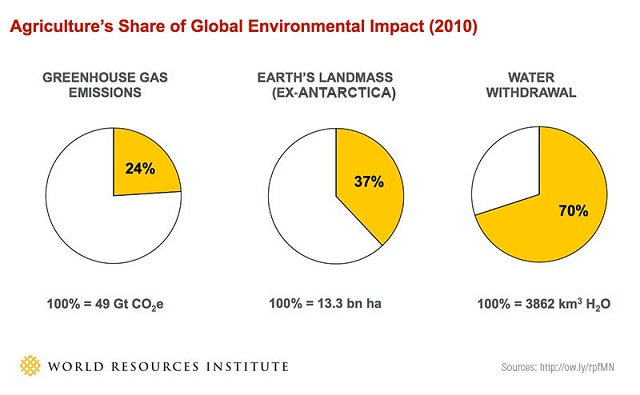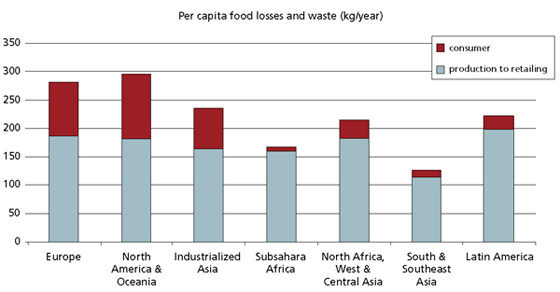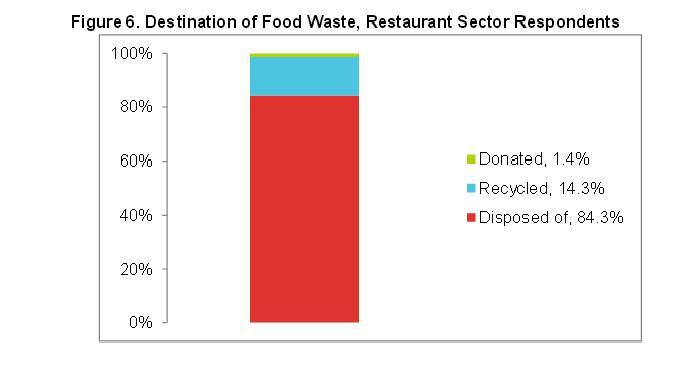Coping with Food Waste
By Yotaro Sueoka and Franklin Zhang
In today’s society, where food distribution and food scarcity come up as serious problems, minimizing food waste is one of the key problems to tackle. Food loss, or food waste, is defined by the FAO (Food and Agriculture Organization) as “the decrease of food in subsequent stages of the food supply chain intended for human consumption.”1 As the way the term is described, intentionally giving animals human food is also in the range of food loss. Using this definition, the amount of thrown-away food differs from country to country, but averages at 8-10% in Germany and an even greater value of 40% in the US.2,3

Figure 1. Agriculture’s share of global impact on greenhouse gas emissions, use of Earth’s land mass and use of water resources.4
Excessive food loss has a detrimental effect on other sustainability issues. The above image shows how the problem of food production ties into other significant problems related to sustainability. Figure 1 shows that in 2010, 24% of global CO2 emissions, 37% of the world’s non-Antarctica landmass and 70% of water withdrawal is related to agriculture. Agriculture uses a lot of energy involved in transportation of food, farming, creating fertilizers and storing food. Growing crops and raising livestock both use up a considerable amount of land and water. Decreasing food waste can minimize such side effects by suppressing inefficient food production.
Types of Food Waste
Food waste either comes from the FSC (food supply chain) or from post-consumer activity. In urbanized areas, the FSC is well-connected, leaving less room for food loss. This characteristic is particularly notable in the post-harvest process; with advanced technology, just 0.07-2.81% of barley is lost in the harvesting process.5 This results in a greater proportion of consumer-related waste in urbanized areas compared to rural areas.2 Figure 2 highlights the fact that food loss per capita by consumers is indeed conspicuous in the industrialized areas; Europe, North America & Oceania, and Industrialized Asia have three times more food loss by consumers than the other four regions.6 Whereas food loss in the supply chain is mainly due to technical hindrances, human behavior accounts greatly for the post-consumer food waste.2 In fact, 60% of the food and drink waste in the UK from household is avoidable.7 Should the food not be wasted on the consumer end, the population would be nourished with a smaller supply of food.

Figure 2. The portion of per capita food waste due to consumers and production/retailing.6
Consumer-Related Food Waste
Consumer-related waste is mainly produced by either household or stores and restaurants. It is needless to say that distinct measures must be taken for each of them, as incentives and regulation would work in a different manner.
Destination of Food Waste, Restaurant Respondents

Figure 3. Majority of food waste in restaurants is disposed of without being recycled or donated.8
Restaurants and stores generate a great deal of waste due to the difference between forecasted demand and reality. Food that is bought in but was either not served or left over becomes the food waste. Figure 3 shows that restaurants, where 15.7% of food is wasted, generate a large portion of global food waste. 84.3% of the food wasted is then disposed of instead of being donated or recycled.8 There is a lot of potential to eliminate food waste in the restaurant sector. However, there are numerous legal issues to overcome because of the liability problems with donating food. Restaurants and stores are often afraid to donate food for the negative consequences that may occur if someone receiving the donated food develops health issue. Some scientists observed food-borne transmission of hepatitis E, implying that the concerns by the restaurants and stores are reasonable.9 Without some form of incentives, stores not giving out leftover foods can be justified despite the CSR (corporate social responsibility) benefits. One provision is to set food waste policies that waive the liability of restaurants and stores under the condition that the food providers fulfilled their duty to maintain utmost safety. This example can be found in the US, where they implement the Federal Bill Emerson Good Samaritan Food Donation Act of 1996 which protects the food providers as long as they give out wholesome foods without gross negligence.10 Tax exemptions and other economic incentive are other forms of policies apt to be introduced to promote participation of companies. In some cases, the transportation costs of delivering the food may prevent restaurants and stores from doing so. The EPA notes that the attempts of stores and restaurants within close proximity collaborating to pay for the transportation costs to collect and distribute donated food has been successful with small businesses, cutting down on the costs.8
Post-Consumer Food Waste
Cutting down on post-consumer food waste requires a different approach. To incentivize consumers to reduce waste, cities should adopt a RFID trash system. This is a high tech food waste disposal bin that charges food waste by weight. The food is composted and turned into fertilizer to be reused. These bins should be strategically located near residential areas, restaurants, grocery stores, parks, schools and other areas that produce lots of food waste.11
Seoul, South Korea is currently experimenting with food waste management policies which include RFID garbage bins and government laws on food waste management. They put bans on food waste in landfills and charge for food waste. With these policies in place, South Koreans have become very conscious about food waste.4 They were able to cut food waste by 119 tonnes a day from 2012 to 2014.
Alternatively, cities can provide public food waste collection services, where the local government provides a place where the residents can drop off food for compost. By paying truck drivers to drive to restaurant districts and collect left overs at the end of the day, the city can offer more jobs.12 Such a plan was implemented in the city of Takoma Park, and showed that 30% of the food trashed was actually compostable.
Education
Education plays an important role as well.13 Jones et al. developed an educational program which teaches elementary school kids the importance of having a balanced diet, while emphasizing on the value of food sustainability. This is especially influential as statistics suggest that food is wasted mostly by the youth.14 Combined with outside-of-school education, such as public symposiums, the program might be successful in shifting people’s mindsets.2 Since there is a considerable factor of human dynamics that plays a role in the production of food waste, such as a trend of buying more short shelf-life food in affluent countries, providing consumers with various information must be taken with great care.
Technology
Investments in food storage and recycling technologies is also important. For example, a more efficient compost or a refrigerator that preserves food longer can aid in diminishing the waste produced within the household.7 Study suggests that applying ultrasound can disrupt microorganisms, thus preventing the deterioration of food and lessening the amount of food thrown away before cooked. 15 Implementing technologies and policies to help people be more sustainable is important, but developing technologies to recycle food are just as important. Thus, governmental funding for creating such technologies is desired. For example, a more efficient compost or a refrigerator that preserves food longer can aid in diminishing the waste produced within the household. Implementing the technology and policies to get people to be more sustainable is important, but the technologies that actually recycle food is just as important.
These solutions aim to get consumers involved in reducing food waste. Regulations, economic incentives, and technology can provide consumers and industries with the motivation and tools to promote sustainability.
